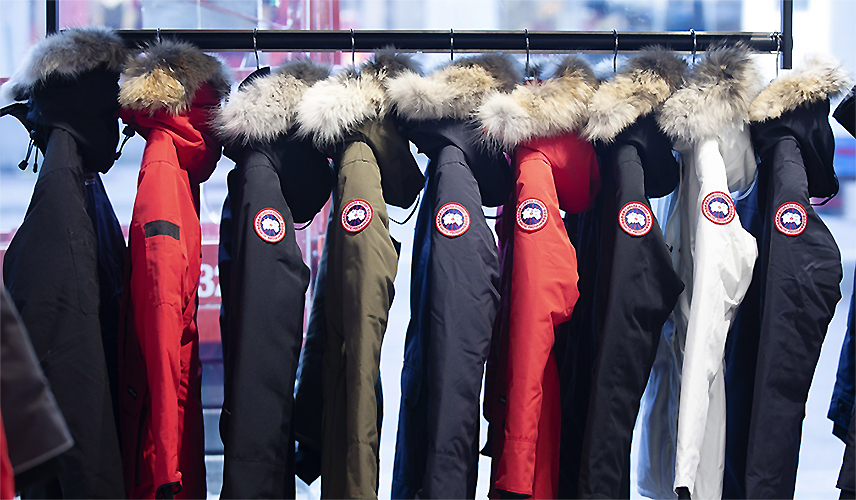<span style="color: #9e9d9d;">Canada Goose Holdings Inc. beat Wall Street expectations for the fiscal second quarter ended September 27, posting a profit on lower revenues in the period. GOOS shares were up nearly 7 percent on Thursday after the company pointed to strength in China and its e-commerce business.
Total revenues decreased 33.7 percent to CN$194.8 million in the fiscal second quarter versus CN$294.0 million in the year-ago period, representing a sequential improvement from fiscal Q1 when revenues fell 63.3 percent. Wall Street’s consensus estimate was CN$148.3 million.
“Reflecting on our progress in quarter two, there are three key things that stand out,” said company EVP and CFO Jonathan Sinclair. Our two strategic priorities, Mainland China with e-commerce are leading the way in our recovery. Our high margin business model, and our implemented savings initiatives, are driving profitability and cash flow. And we’re entering the peak season in an agile position. We are unlocking cash through inventory already staged while retaining commercial flexibility.
DTC channel revenue decreased by 37.7 percent to CN$46.2 million in what GOOS describes as a “seasonally slow period” before heating up for peak demand in fiscal Q3 period. Management said the DTC decline was driven by “lower contributions from stores in North America and Europe in the early stages of reopening.” Traffic was said to be “significantly lower” due to the pandemic as the vertical retailer dealt with reduced operating hours and limited occupancy levels. Within the DTC business, e-commerce was said to be a bright spot, with double-digit revenue growth for the quarter with a significant acceleration in trend in September.
“Digital will obviously play an important role in the future of retail, and we will continue to invest in expanding both wholly-owned international e-commerce and our omnichannel solutions,” explained company President and CEO Dani Reiss. “The strength of our e-commerce business will remain an important asset and business driver as digital adoption continues to grow among consumers globally.”
Sinclair reported that Mainland China was the first market to return to growth with DTC revenue increasing over 30 percent in the period. “From a near-total shutdown only nine months ago, this is a powerful recovery,” he said. “Foot traffic has normalized, the consumer is eager to spend and brand momentum is strong.”
The company continues to execute against its seven committed store openings for the year — this includes Mainland China, where there are four stores, two high-conviction locations in Toronto and Ottawa, one in Berlin. Performance-to-date in its new stores in China was said to be “very encouraging.”

Reiss expanded on the China conversation noting, “As we set out to do, we concentrated our new store expansion efforts for the year in this market, more than doubling our footprint so far. We’ve continued to make significant investments in this important luxury market to drive a long term and sustainable business in the region for years to come. With this foundation in place, against a backdrop of the continued acceleration of sales that we’ve seen beyond Q2, I’m very optimistic about the strategic approach that we have taken to market.”
<span style="color: #9e9d9d;">Wholesale revenue was reportedly down 45.7 percent to CN$118.5 million compared to CN$218.1 million in the year-ago period in what is historically the largest quarter for its wholesale business. The decrease was reportedly due to the continued impact from COVID-19 including the significant reduction in its planned order book and requests from the company’s partners and international distributors for later shipment timed relative to the comparative quarter.
Other revenue was CN$30.1 million versus CN$1.7 million in fiscal Q2 last year. The increase was reportedly driven by PPE sales in support of COVID-19 response efforts.
Turning to the current business environment Sinclair said they see further improvement across its business, “particularly in the DTC channel.” Results in mainland China are reportedly at pre-pandemic levels. The brand’s performance during Golden Week was said to be “reassuringly strong with a notable pickup in traffic driven by domestic tourism.” Hong Kong, however, is reportedly a “very challenged or very contained situation” after operations there were disrupted at this time last year. GOOS continues to see “significantly lower revenue and near-total shut-off of inbound and outbound tourism” due to quarantine requirements and local economic conditions.
In North America, Sinclair said all stores are currently in operation, including a recent expansion of its Yorkdale store in Toronto, nearly doubling its footprint. “Yorkdale has consistently proven itself to be one of our most productive locations since opening in 2016, and I look forward to its continued success especially heading into our peak selling season,” Reiss said.
In Europe, all three stores are closed, again, due to government mandate. London and Milan began a full-week closure this week, and Paris is closed for at least two more weeks. “For those that are open, material pressures on traffic and capacity remain, but we’re pleased to see local guests gravitating back,” said Sinclair.
“Irrespective of the pandemic, we remain confident in the strategic value and profitability of our highly selective network,” Sinclair said. “Assuming no further closures, we expect to offset a greater proportion of these retail declines through e-commerce. Across key markets, our sites have continued to accelerate since September, at the time of year where it really matters for our performance. Digital is moving in the right direction, with higher growth rates on a bigger base.”

In wholesale, GOOS expects to see a better rate of decline relative to the fiscal second quarter driven by “later shipment timing with more of an in-season fulfillment model.” Sinclair said the company is in a “good and clean position due to the proactive measures” taken throughout the pandemic. He noted operational and financial risks remain, including the recent closures in Europe. “We will continue to take a brand-first approach while increasing our strategic emphasis on DTC,” he explained.
<span style="color: #9e9d9d;">In terms of profitability, the adjusted EBIT margin was 8.1 percent despite significant disruptions to its top-line results.
Total SG&A expenses decreased by 15.1 percent in the quarter. This achievement was said to be supported by variable components in the company’s cost base, including marketing and contingent rent, as well as implemented savings initiatives. GOOS expects SG&A to be in line with last year in the back of the fiscal year. Sinclair said the step-up is driven by strategic investments in brand building and demand building focused on e-commerce and Mainland China.
“While still delivering on our long-term growth strategy, early in the pandemic, we took a rigorous approach to assess our SG&A,” said Reiss. “Our high margin model, combined with our savings initiatives, is paying off. While we have taken a flexible approach to manage our expenses where opportunity exists, we have approached incremental investment opportunities with decisiveness. In our current environment, we see opportunity in building our brand through strategic marketing to grow demand and to reach the volumes.”
Gross margin was 48.4 percent of sales in the quarter, compared to 54.6 percent of sales in the year-ago period. The decrease in gross profit was attributed to the decline in revenue partially offset by CN$7.8 million of government payroll subsidies. The decrease in gross margin was a result of a higher proportion of Other revenue partially offset by a higher DTC gross margin. Excluding the impact of the sale of PPE, gross margin was 56.1 percent, or 150 bps, above the comparative quarter.
DTC gross margin was 76.8 percent in fiscal Q2, compared to 75.6 percent in the year-ago quarter, impacted by the decline in segment revenue. The increase in gross margin was attributable to CCN$0.8 million (+170 bps) of government payroll subsidies partially offset by CN$0.4 million (-90 bps) of higher costs per unit as production levels were limited and also impacted by COVID-19 safety protocols at the company’s manufacturing facilities.
Wholesale gross margin came in at 47.6 percent of sales, compared to 47.6 percent in fiscal Q2 last year. Gross margin remained flat, and included CN$7.0 million (+570 bps) of government payroll subsidies, offset by CN$3.8 million (-310 bps) of higher costs per unit as production levels were limited and also impacted by COVID-19 safety protocols at our manufacturing facilities and CN$2.2 million (-180 bps) resulting from a higher proportion of distributor sales relative to the year-ago quarter.
Other segment gross profit was CN$2.3 million versus CN$0.5 million in the year-ago period. PPE gross profit and gross margins were CN$1.0 million and 3.5 percent of sales.
Net income was CN$10.4 million, or CN 9 cents per diluted share, in the fiscal second quarter, compared to net income of CN$60.6 million, or CN 55 cents per diluted share, in the prior-year comp period.
Adjusted net income was CN$11.5 million, or CN 10 cents per diluted share, compared to adjusted net income of CN$63.6 million, or CN 57 cents per diluted share. Wall Street’s consensus estimate was reported at CN 8 cents per share.
<span style="color: #9e9d9d;">Looking to operations, Sinclair said the company is on track for its peak season. “In manufacturing, we’ve had a smooth and successful restart down-filled jacket production at all eight facilities across Canada. Doing this in the middle of the pandemic, and alongside PPE manufacturing, is no small task. It is truly a testament to the grit of our amazing team.”
GOOS also completed a third-party logistics transition to enhance the scalability of its distribution and e-commerce service levels worldwide. The first phase of the digital cross-border initiative is said to be complete with 18 new countries turned on during the second quarter. “We’re excited to continue expanding the global campus of our in-house e-commerce business,” said Sinclair. “In-store Omni shopping is also going live as we speak in U.S. retail. We expect this to be a real needle mover for experience and for conversion.”
In closing, Sinclair spoke briefly on the not-for-profit PPE manufacturing activities. “We’re now nearing the end of completion of the current contractual obligations. As a result, we expect revenue in the Other segment in Q3 to be down to just over one-third of the level we had in Q2,” he said.
Canada Goose upsized its loan to US$300 million and extended its maturity through 2027. This shifts a portion of its short-term borrowings to a more permanent capital base while maintaining low leverage and a flexible covenant like structure.
Photo courtesy Canada Goose, Bloomberg, Reuters
















